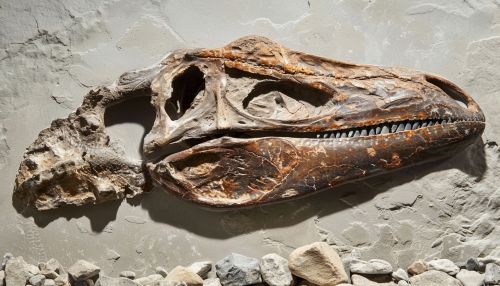Pseudosuchia
Overview
Pseudosuchians are a group of archosaurs that include all archosaurs more closely related to crocodiles than to dinosaurs. This group was first named by the German paleontologist Friedrich von Huene in 1915 as a way to refer to a number of related forms he considered to be "false crocodiles". The group has undergone various revisions and expansions over the years, and now includes a wide array of extinct forms, as well as the living crocodilians.
Taxonomy and Evolution
The taxonomy of Pseudosuchia is complex and has been the subject of much debate. The group was first defined as a clade by the American paleontologist Paul Sereno in 1991, who used the name to refer to the most inclusive clade containing crocodiles but not dinosaurs. This definition has been widely accepted and is used in most modern studies of archosaur phylogeny.
Pseudosuchians are part of the larger group Archosauria, which also includes dinosaurs and birds. The split between the lineages leading to pseudosuchians and dinosaurs is thought to have occurred in the Late Permian or Early Triassic period, following the Permian–Triassic extinction event, one of the most devastating mass extinctions in Earth's history.


Morphology and Anatomy
Pseudosuchians exhibit a wide range of body sizes and shapes, reflecting their diverse lifestyles and ecological roles. Many early pseudosuchians, such as Erythrosuchus, were large, quadrupedal predators with long, narrow skulls and powerful jaws. Later forms, such as the aetosaurs, were heavily armored herbivores, while others, like the rauisuchians, were large, bipedal predators.
One of the key features distinguishing pseudosuchians from other archosaurs is the structure of their ankle joint. In pseudosuchians, the joint is crurotarsal, meaning that it allows for a high degree of flexibility and rotation. This is in contrast to the more rigid, hinge-like ankle joint found in dinosaurs and birds.
Ecology and Behavior
The ecology and behavior of pseudosuchians are inferred from their morphology and the environments in which their fossils are found. Early pseudosuchians were likely dominant terrestrial predators, while later forms occupied a variety of ecological roles, from herbivores to omnivores and carnivores.
Behaviorally, pseudosuchians likely exhibited a range of behaviors similar to those of modern crocodiles, including territoriality, parental care, and complex social interactions. However, these inferences are largely speculative, as direct evidence of behavior is rare in the fossil record.
Fossil Record and Distribution
Pseudosuchians have a rich fossil record that spans much of the Mesozoic Era. The earliest known pseudosuchians are from the Late Permian of Russia, while the most recent are from the Late Cretaceous of North America. Pseudosuchian fossils have been found on every continent, including Antarctica, reflecting their wide geographic distribution and ecological diversity.
Extinction and Survival
The majority of pseudosuchian lineages went extinct during the Triassic–Jurassic extinction event, likely due to a combination of environmental changes and competition with early dinosaurs. However, one lineage, the Crocodylomorpha, survived and eventually gave rise to the modern crocodilians.
